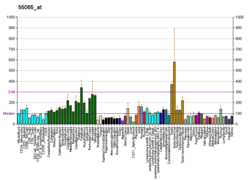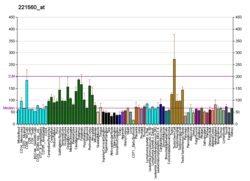MARK4
Appearance
MAP/microtubule affinity-regulating kinase 4 is an enzyme that in humans is encoded by the MARK4 gene.[5][6][7]
Interactions
MARK4 has been shown to interact with USP9X[8] and Ubiquitin C.[8]
References
- ^ a b c GRCh38: Ensembl release 89: ENSG00000007047 – Ensembl, May 2017
- ^ a b c GRCm38: Ensembl release 89: ENSMUSG00000030397 – Ensembl, May 2017
- ^ "Human PubMed Reference:". National Center for Biotechnology Information, U.S. National Library of Medicine.
- ^ "Mouse PubMed Reference:". National Center for Biotechnology Information, U.S. National Library of Medicine.
- ^ Kato T, Satoh S, Okabe H, Kitahara O, Ono K, Kihara C, Tanaka T, Tsunoda T, Yamaoka Y, Nakamura Y, Furukawa Y (Apr 2001). "Isolation of a novel human gene, MARKL1, homologous to MARK3 and its involvement in hepatocellular carcinogenesis". Neoplasia. 3 (1): 4–9. doi:10.1038/sj/neo/7900132. PMC 1505019. PMID 11326310.
- ^ Drewes G, Ebneth A, Preuss U, Mandelkow EM, Mandelkow E (May 1997). "MARK, a novel family of protein kinases that phosphorylate microtubule-associated proteins and trigger microtubule disruption". Cell. 89 (2): 297–308. doi:10.1016/S0092-8674(00)80208-1. PMID 9108484.
- ^ "Entrez Gene: MARK4 MAP/microtubule affinity-regulating kinase 4".
- ^ a b Al-Hakim AK, Zagorska A, Chapman L, Deak M, Peggie M, Alessi DR (Apr 2008). "Control of AMPK-related kinases by USP9X and atypical Lys(29)/Lys(33)-linked polyubiquitin chains". Biochem. J. 411 (2): 249–60. doi:10.1042/BJ20080067. PMID 18254724.
Further reading
- Nagase T, Nakayama M, Nakajima D, Kikuno R, Ohara O (2001). "Prediction of the coding sequences of unidentified human genes. XX. The complete sequences of 100 new cDNA clones from brain which code for large proteins in vitro". DNA Res. 8 (2): 85–95. doi:10.1093/dnares/8.2.85. PMID 11347906.
- Beghini A, Magnani I, Roversi G, Piepoli T, Di Terlizzi S, Moroni RF, Pollo B, Fuhrman Conti AM, Cowell JK, Finocchiaro G, Larizza L (2003). "The neural progenitor-restricted isoform of the MARK4 gene in 19q13.2 is upregulated in human gliomas and overexpressed in a subset of glioblastoma cell lines". Oncogene. 22 (17): 2581–91. doi:10.1038/sj.onc.1206336. PMID 12735302.
- Trinczek B, Brajenovic M, Ebneth A, Drewes G (2004). "MARK4 is a novel microtubule-associated proteins/microtubule affinity-regulating kinase that binds to the cellular microtubule network and to centrosomes". J. Biol. Chem. 279 (7): 5915–23. doi:10.1074/jbc.M304528200. PMID 14594945.
{{cite journal}}: CS1 maint: unflagged free DOI (link) - Brajenovic M, Joberty G, Küster B, Bouwmeester T, Drewes G (2004). "Comprehensive proteomic analysis of human Par protein complexes reveals an interconnected protein network". J. Biol. Chem. 279 (13): 12804–11. doi:10.1074/jbc.M312171200. PMID 14676191.
{{cite journal}}: CS1 maint: unflagged free DOI (link) - Schneider A, Laage R, von Ahsen O, Fischer A, Rossner M, Scheek S, Grünewald S, Kuner R, Weber D, Krüger C, Klaussner B, Götz B, Hiemisch H, Newrzella D, Martin-Villalba A, Bach A, Schwaninger M (2004). "Identification of regulated genes during permanent focal cerebral ischaemia: characterization of the protein kinase 9b5/MARKL1/MARK4". J. Neurochem. 88 (5): 1114–26. doi:10.1046/j.1471-4159.2003.02228.x. PMID 15009667.
- Rual JF, Venkatesan K, Hao T, Hirozane-Kishikawa T, Dricot A, Li N, Berriz GF, Gibbons FD, Dreze M, Ayivi-Guedehoussou N, Klitgord N, Simon C, Boxem M, Milstein S, Rosenberg J, Goldberg DS, Zhang LV, Wong SL, Franklin G, Li S, Albala JS, Lim J, Fraughton C, Llamosas E, Cevik S, Bex C, Lamesch P, Sikorski RS, Vandenhaute J, Zoghbi HY, Smolyar A, Bosak S, Sequerra R, Doucette-Stamm L, Cusick ME, Hill DE, Roth FP, Vidal M (2005). "Towards a proteome-scale map of the human protein-protein interaction network". Nature. 437 (7062): 1173–8. doi:10.1038/nature04209. PMID 16189514.
- Wissing J, Jänsch L, Nimtz M, Dieterich G, Hornberger R, Kéri G, Wehland J, Daub H (2007). "Proteomics analysis of protein kinases by target class-selective prefractionation and tandem mass spectrometry". Mol. Cell. Proteomics. 6 (3): 537–47. doi:10.1074/mcp.T600062-MCP200. PMID 17192257.
{{cite journal}}: CS1 maint: unflagged free DOI (link)






